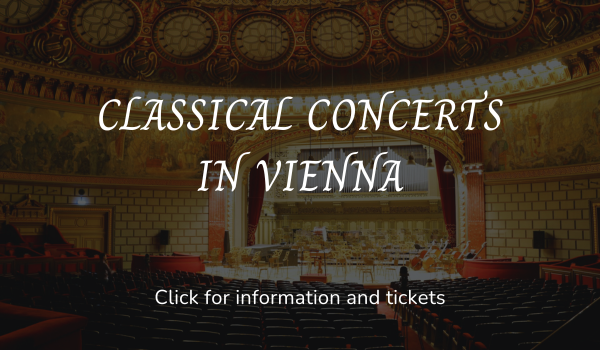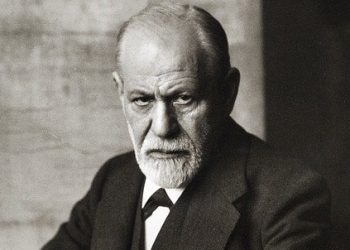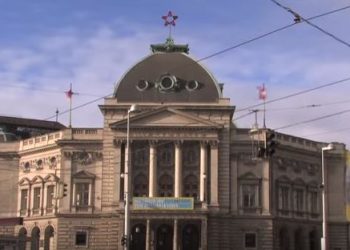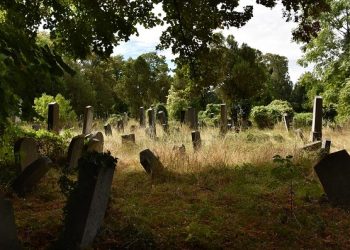At the Vienna State Opera (Wiener Staatsoper), approximately 350 performances are held each season, with around 600,000 spectators enjoying Viennese culture at its best. If you fancy soaking up some local culture, there’s no doubt that the Opera House is the perfect place. You can even buy a ticket to an opera performance for 5 to 10 Euros (standing room only). Another option is to watch live performances through the Opera House’s broadcasting system. In addition to all this, there are daily guided tours for visitors.
This article provides a comprehensive overview of the Vienna State Opera:
- The Story of the Opera House (First and Second Opera Buildings)
- The Unique Architecture of the Opera House
- Behind the Scenes of the Opera
- The Auditorium
- Art Exhibition at the Opera House
- Performances and Concerts at the Opera House
- Guided Tours of the Opera House
- Additional Essential Information for Your Visit
- Essential Information for Your Visit
The Story of the Opera House
Like many buildings in Vienna, the Opera House was built for the enjoyment of the Habsburg family who ruled Austria. Initially, it was called the “Royal Opera House” (Wiener Hofoper), and after the fall of the monarchy and the establishment of the Republic of Austria, its name was changed to the Vienna State Opera (Wiener Staatsoper).
The First Opera Building
The construction of the Opera House took approximately 8 years, from 1861 to 1869. Its planning and design were carried out by architects August von Sicardsburg and Eduard van der Nüll. The architects designed the building in the Neo-Renaissance style. Their goal was to build a magnificent and ornate building, and therefore they demanded that the construction be done with special stones that were not common at all in Vienna (Wöllersdorfer stones, for example). The interior of the building was adorned with various styles of marble stones.
Despite the significant investment in the planning and construction of the Opera, the city’s residents did not find it particularly beautiful, and there was much criticism of it. The residents claimed it was not at all impressive compared to the private residential building next to it (the building was called Heinrichshof and was completely destroyed during World War II, so it cannot be visited today). The resounding failure and public disappointment led to devastating results. The architect Eduard van der Nüll committed suicide, and his partner August von Sicardsburg suffered a heart attack ten weeks later and also died. In fact, neither of the architects lived to see the completion of the Opera House they designed.
In 1869, the Opera House officially opened with the premiere performance of Mozart’s “Don Giovanni.” Emperor Franz Joseph and his wife Elisabeth (known as Sisi) attended this event.
For about 65 years, the Opera House operated continuously, and many important performances took place there. Its most significant flourishing was during the period of Gustav Mahler, who was the director of the Opera. Mahler upgraded the performance system and turned it into an incredibly well-oiled and precise machine.
The period of World War II was devastating for the Opera House. Between 1938 and 1945, the Nazis ruled Austria, and as a result, many artists were dispossessed of their positions, persecuted, and some were even murdered. The Nazis banned many performances and severely damaged the functioning of the Opera House.
In the last days of the war, amidst the Allied bombing, the Opera House was severely damaged, and large parts of it were completely destroyed, including the auditorium and the stage. Approximately 150,000 different costumes burned in the flames that raged through the building. Fortunately, the front part, including the decorated foyer, the main staircase, the corridor, and the tea room, survived the bombings.
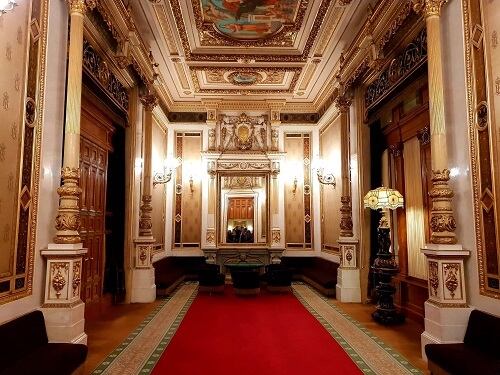
The Second Opera Building
The destroyed Opera House led to lengthy discussions regarding its future. Some argued that the remnants of the building should be completely demolished and a new, modern opera house built in its place, but on the other hand, there were those who proposed restoring the building to its original state. Not surprisingly, it was decided to restore the Opera House according to the original plan, and the renovation work took approximately 8 years.
During the renovations, the Opera operated in a temporary building that was not suitable for the needs of the performances. Therefore, the Opera’s management tried to raise funds to expedite the renovation work. Many donations were given by city residents who wanted to feel part of the rehabilitation project, and even raw materials were donated by the Soviets. Despite efforts to complete the construction as quickly as possible, the renewed Opera House only opened at the end of 1955. The first performance held in the renewed building was Beethoven’s Fidelio, conducted by Karl Böhm. Another equally important event occurred at this event – the first live broadcast in Austria.
As part of the restoration work, changes and upgrades were also made to the building. The auditorium was slightly reduced from 2881 seats to 2284 seats, and wood paneling was added to improve acoustics.
Today, the Vienna State Opera is considered one of the best opera houses in the world. Each performance season sees no less than 350 performances, showcasing about 60 opera and ballet productions in various styles, from the Baroque period to the present day. You can enjoy a performance almost every night of the week. The wide variety of performance types is the largest in the entire world of opera. In addition, the Opera House invests heavily in the city’s children, and many children’s groups learn singing and dancing there and perform in a special tent located on the building’s roof (the tent is called Mobilkom). The total staff numbers about 1000 people!
In 2013, an online streaming service for opera performances even began operating, much like a Netflix for the Opera House. For more information.

The Unique Architecture of the Opera House
There is no doubt that in terms of the building’s architecture, it is certainly exceptional and impressive.
The exterior of the building, facing the Ringstrasse, is the part that survived the shelling during World War II and has stood since 1869. The outer walls are designed in a Renaissance style with many arches, and its balcony facing the Ringstrasse emphasizes its nature as a public building.
On both sides of the building at its front, there are statues of riders on their horses. The statues were placed there already in 1876. The statues were sculpted by Ernst Julius Hähnel and represent the winged horses of the Muse Erato from Greek mythology.
Above the arches over the balcony are 5 copper statues, sculpted by Hähnel. The statues represent (from left to right) the themes of: Heroic Valour, Tragedy, Fantasy, Comedy, and Love. In addition, on both sides of the building there are two fountains representing two different worlds – on one side (the left) the world of music, dance, and joy, and on the other side (the right) the world of sorrow, revenge, love, and temptation.
The building itself is not symmetrical, and its rear part is wider than its front part. The stage and the surrounding rooms are located in the rear of the building, and the auditorium is in the front.
Behind the Scenes of the Opera
The stage and the backstage area were built after the war on top of the first structure. Between 1991 and 1993, as part of additional renovation work, advanced technological systems were also installed, including microphones, speakers, and video. In addition, the electrical, heating, and fire extinguishing systems in the building were renovated.
In addition to the various rehearsal rooms for opera performances, there are also three rehearsal rooms for the choir and orchestra, as well as an organ room on the sixth floor. This is a huge organ with 2500 pipes, and in fact, the Vienna State Opera is the only one in the world with such a large organ.
The Auditorium
The auditorium hall is built in a semi-circular shape. Its current capacity is 2284 people (the capacity of the original hall was 2881 people). There are 1709 seating places, 567 standing places (tickets are very cheap for those standing), and 4 places for people with disabilities who use wheelchairs.
The dominant colors in this room are red, gold, and ivory. In the past, there was a large chandelier in the center of the room, but it was replaced by another lamp for safety reasons.
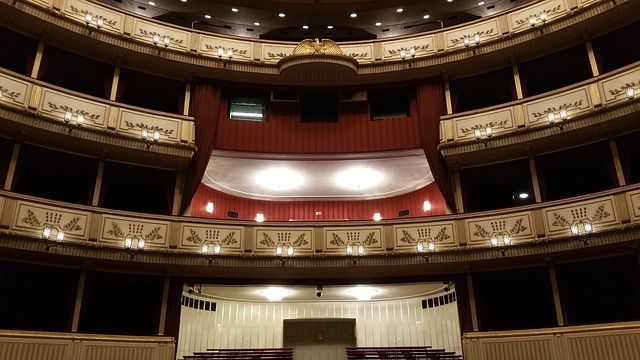
Art Exhibition at the Opera House
Since 1998, a unique and different art exhibition has begun at the Opera House. The exhibition is called “Safety Curtain.” This exhibition is actually displayed on the curtain separating the audience from the artists on stage. Huge paintings by various esteemed artists are displayed on the separating curtain. Currently, a painting by the American artist John Baldessari is on display. You can admire the interesting designs here.
Performances and Concerts at the Opera House
Almost every day of the week, a wonderful opera performance takes place at the Opera House. The performances are elaborate and stunningly beautiful, so there is no doubt that an evening at the opera is an unforgettable experience. You can view the list of various opera performances on the official website of the Opera House and purchase tickets directly from there.
In addition, the box offices at the Opera House are open every Monday to Saturday from 9:00 AM until one hour before the performance (on Saturdays, the box offices are open until 5:00 PM). On Sundays and holidays, the Opera House box offices are closed. Please note: you can purchase tickets for the standing area. These tickets are very inexpensive (between 5 and 10 Euros). In any case, it is advisable to arrive in respectable and elegant attire.
Good to know: Every year, from spring until the end of summer, various opera performances are broadcast on a screen located in the plaza outside the building. You can watch the performances for free on the big screen. If you arrive early enough, you can even snag excellent seating.
Get a glimpse of a Mozart performance at the Opera House:
If you are interested in classical music concerts, we have prepared a list of recommendations compiling the various concerts available in the city. The concerts take place in various impressive venues such as Schönbrunn Palace, central churches, and also the concert hall of the Society of Friends of Music.
Guided Tours of the Opera House
A guided tour of the Opera House will allow you to glimpse behind the scenes of one of the best theaters in the world. The tour lasts about 40 minutes, and during it, you will hear interesting facts about the building’s history, its architecture, and how it operates today.
The tour begins in the entrance hall and from there up the impressive staircase towards the various rooms: the Tea Room, the Marble Hall, and the Gustav Mahler Auditorium. At the end of the tour, you will be able to see the auditorium and the stage.
Tour times: Monday to Sunday. The tour does not depart at fixed times every day. Please check here for tour times on your desired days.
Tour languages: German, English, Spanish. Tours can also be arranged in advance in Italian, French, and Russian.
Booking tickets for the tour: Tickets for tours can be booked on the Opera’s website.
Meeting point:
Goethegasse 1 Wiener Staatsoper Guided tours
If you do not wish to join a guided tour, but still want to admire the building, you can take a virtual tour.
Additional Essential Information for Your Visit
The Opera House is located in a central area on Vienna’s Ringstrasse. It is next to Vienna’s largest subway station, Karlsplatz Station.
How to get to the Opera House?
You can take the subway using lines U1 (red line), U2 (purple line), or U4 (green line). Get off at Karlsplatz station and look for the Opera exit. The sign will show the word “Oper,” and from there, you should take the escalators to the upper level.
Address: Opernring 2, 1010 Wien
Map:
In the vicinity of the Opera House, you can visit several other attractions: St. Charles Church, Hofburg Palace, Burggarten, the Museum Quarter, and Mariahilfer shopping street. You can also walk from the Opera House into the Old City to St. Stephen’s Cathedral. If you are interested in additional classical activities in the city, it’s worth reading about the best classical concerts you can visit during a trip to Vienna.



